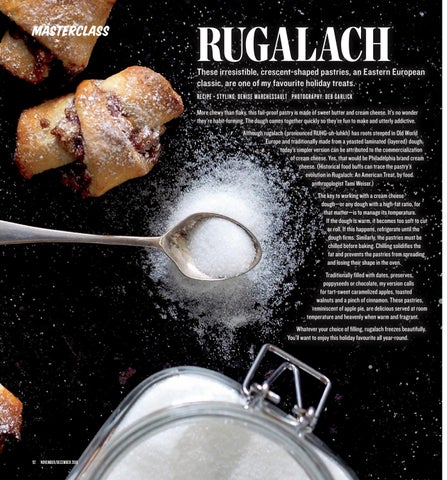masterclass
RUGALACH
These irresistible, crescent-shaped pastries, an Eastern European classic, are one of my favourite holiday treats. RECIPE • ST YLING: DENISE MARCHESSAULT PHOTOGRAPHY: DEB GARLICK More chewy than flaky, this fail-proof pastry is made of sweet butter and cream cheese. It’s no wonder they’re habit-forming. The dough comes together quickly so they’re fun to make and utterly addictive. Although rugalach (pronounced RUHG-uh-luhkh) has roots steeped in Old World Europe and traditionally made from a yeasted laminated (layered) dough, today’s simpler version can be attributed to the commercialization of cream cheese. Yes, that would be Philadelphia brand cream cheese. (Historical food buffs can trace the pastry’s evolution in Rugalach: An American Treat, by food anthropologist Tami Weiser.) The key to working with a cream cheese dough—or any dough with a high-fat ratio, for that matter—is to manage its temperature. If the dough is warm, it becomes too soft to cut or roll. If this happens, refrigerate until the dough firms. Similarly, the pastries must be chilled before baking. Chilling solidifies the fat and prevents the pastries from spreading and losing their shape in the oven. Traditionally filled with dates, preserves, poppyseeds or chocolate, my version calls for tart-sweet caramelized apples, toasted walnuts and a pinch of cinnamon. These pastries, reminiscent of apple pie, are delicious served at room temperature and heavenly when warm and fragrant. Whatever your choice of filling, rugalach freezes beautifully. You’ll want to enjoy this holiday favourite all year-round.
32 NOVEMBER/DECEMBER 2018
22-06 EAT Magazine Nov-Dec 2018-Oct22.indd 32
2018-10-23 11:20:37 AM
